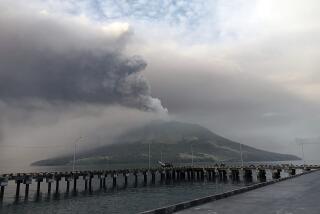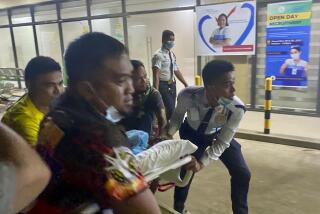Thousands Flee Volcano Blasts in Philippines
- Share via
MANILA — Mt. Pinatubo erupted with a series of thundering explosions early today in the Philippines, spewing towering plumes of steam and gray ash 13 miles into the sky over the crowded plains of central Luzon and sending a deadly mixture of searing gas, flaming rocks and debris sweeping down the volcano’s slopes.
The eruption forced 600 U.S. Air Force personnel, who remained after an evacuation of Clark Air Base on Monday, to flee the base after sirens sounded. About 900 others took shelter in a special command center but remained to guard the facility.
Roads nearby were clogged with cars, jeeps and buses as thousands of terrified local residents tried to escape the volcano’s fury. Church bells pealed in Angeles city, adjacent to the air base, warning the more than 300,000 residents to seek shelter.
There were no immediate reports of injuries. Philippine officials had evacuated about 19,000 villagers in recent days, but others stayed in scattered hamlets to tend to their animals and farms.
Reporters at the scene said the blast created a greenish-gray mushroom cloud “like an atomic bomb,” but volcanologists said the explosions from the long-dormant volcano may only signal larger eruptions to come.
“Let us not consider this one the end of the episode,” said Raymundo Punongbayan, head of the Philippine Institute of Volcanology and Seismology. “It could be the beginning.”
Punongbayan said the area was potentially unsafe within 18 miles of the volcano. Manila, the capital, was unlikely to be affected, he added.
Billowing gray ash clouds could be seen from Manila, 60 miles south of the volcano. A large ash cloud blew over the U.S.-run Subic Bay Naval Base, which is sheltering nearly 15,000 evacuees from Clark.
“It gave us some concern, but it blew out to sea,” Lt. Cmdr. Kevin Mukri, a spokesman for Subic Bay, 21 miles southwest of the volcano, said of the ash cloud.
All telephone lines to Clark were down, and Armed Forces Television was unable to broadcast after at least three eruptions began at 8:51 a.m., following two smaller emissions before dawn. Another eruption occurred shortly before noon.
The 4,795-foot-high volcano, which has been dormant for 600 years, became active again last April and began belching smoke and steam last Friday. Small eruptions occurred Sunday and Monday.
Seismologist Julio Sabit said scientists were installing monitoring equipment on the volcano’s slopes early today when they began to feel a series of tremors.
“Most probably there will be more eruptions,” he said. He said scientists saw “pyroplastic materials,” a deadly mixture of volcanic fragments and gases tumbling down the mountain at high speed.
Punongbayan, head of the volcanolgy institute in Manila, said “many pyroplastic flows” had rolled up to 10 miles down three river valleys on the north, northwest and southwest sides of the mountain toward a thinly populated area.
“These flows destroy everything in their path,” he said in a telephone interview.
Punongbayan said the giant ash clouds had blown to the southwest, away from Clark, and had dropped fine ash on four towns--San Antonio, San Marcelino, San Felipe and San Narciso--in Zambales province. Government evacuation centers in several of the towns hold thousands of villagers who earlier had fled areas closer to the volcano.
“People obviously were terrified,” he said. He said the towns were in no immediate danger, however, and would not be evacuated.
The gray ash also was blanketing nearby fields and farms. Unless the material is cleared, he said, “the land is not tillable for 50 years or more.”
Punongbayan said no lava had been spotted on the volcano. He said the eruptions so far do not compare to Mt. St. Helen’s devastating explosion in Washington state in 1980 because that volcano scattered vast amounts of rock and debris when it blew.
He said that measuring equipment on Mt. Pinatubo was destroyed, however, and that the thick clouds prevented accurate measurements of the volcano’s blasts.
U.S. Embassy spokesman Stanley Schrager said, “Clark is not in immediate danger at this point.”
He said those remaining were instructed to use gas masks or wet towels if ash from the volcano began falling on the base. If conditions worsen, he added, “they’re ready to go immediately if necessary.”
Mayor Antonio Abad Santos of Angeles city, outside Clark, insisted that the “situation is under control.” He noted that winds blew away from the Angeles area. “So the citizens here temporarily are safe, unless the wind changes,” he said in a radio interview. “Be calm. Don’t panic.”
U.S. officials advised the 28,000 Americans at Subic Bay to stay indoors and to shut air-conditioners and windows if ash begins falling on the base. The ash could disrupt computers, telephones and electronic equipment on the base, but poses no immediate health threat, officials said.
Earlier, at Subic Bay, the thousands of displaced American military personnel, their families and even a pet wolf jammed into the already overcrowded naval base.
Using cots, sleeping bags and “bubble wrap” packing material for mattresses, hundreds of families slept in racquetball courts, an officers’ club and two chapels, where the pews were pushed aside and the altars removed. Others doubled or tripled up in 1,100 apartments and homes on the base. A few set up camping tents or slept in their cars.
“We doubled the population overnight,” Rear Adm. Thomas Mercer, head of Subic and commander of U.S. Navy operations in the Philippines, told a group of visiting journalists Tuesday.
Clark, 50 miles north of Manila, is headquarters to the U.S. 13th Air Force. The base has one of the world’s largest aerial combat training ranges and is a major switching point for flights operated by the Military Airlift Command. Built as a U.S. cavalry post in 1901, Clark provided logistic support during the Persian Gulf buildup and war.
If the volcano danger lasts more than two weeks, Mercer said, officials may begin moving some of the evacuees to Guam or back to the United States.
In Washington, Pentagon spokesman Pete Williams said the effective closing of Clark is affecting military operations in the Pacific.
“We can work around it for now and wait another week or so and see how long we’re going to have to keep it shut down,” he said.
The American evacuation has put special strains on this scenic seaside base, which serves as a repair, resupply and training site for the U.S. 7th Fleet.
More to Read
Sign up for Essential California
The most important California stories and recommendations in your inbox every morning.
You may occasionally receive promotional content from the Los Angeles Times.













